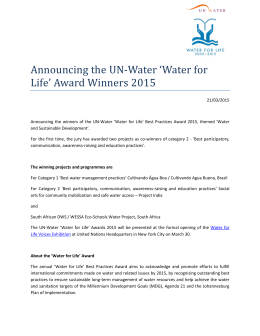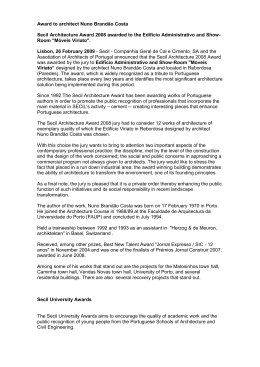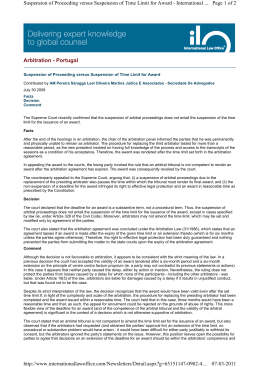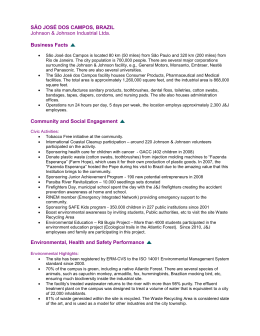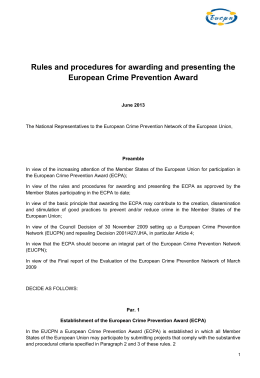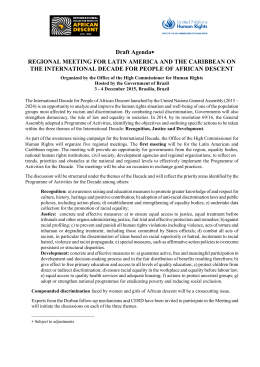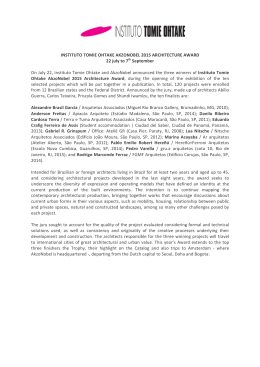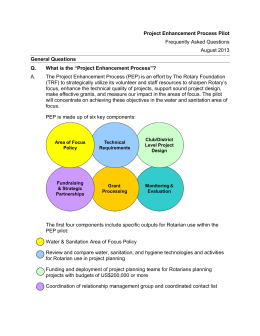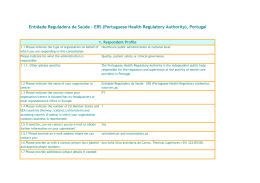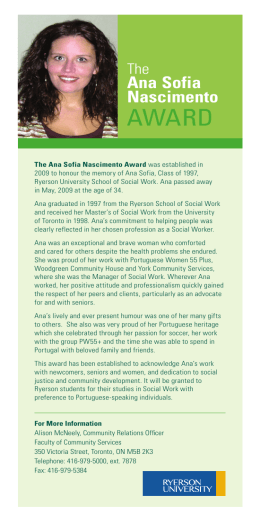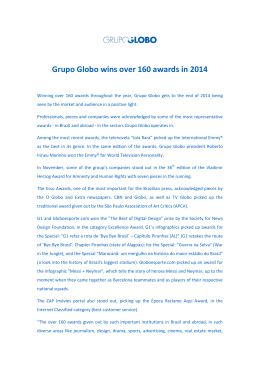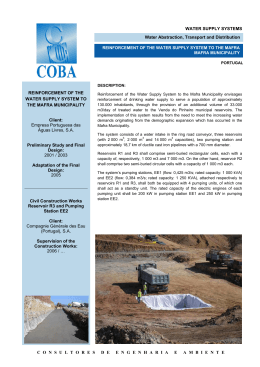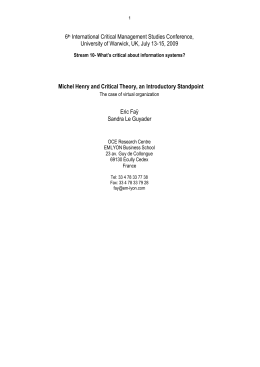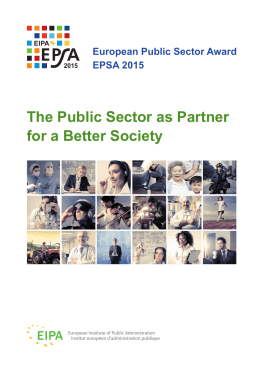“WATER FOR LIFE” BEST PRACTICES AWARD 1. Introduction Water is essential for life. No living being on planet Earth can survive without it. It is a prerequisite for human health and well-being as well as for the preservation of the environment. However, four of every ten people in the world do not have access to even a simple pit latrine; and nearly two in ten have no source of safe drinking water. Beyond meeting basic human needs, water supply and sanitation services, as well as water as a resource, are critical to sustainable development. It is a major source of energy in some parts of the world, while in others its potential as an energy source remains largely untapped. Water is also necessary for agriculture and for many industrial processes. And in more than a few countries, it makes up an integral part of transport systems. Yet in many regions around the world, people and economies continue to suffer from its extremes. With improved scientific understanding, the international community has also come to appreciate more fully the valuable services provided by water-related ecosystems, from flood control to storm protection and water purification. Water challenges will increase significantly in the coming years. Continuing population growth, coupled with its mobility, and rising incomes will lead to greater water consumption, as well as more waste. The urban population in developing countries will grow dramatically, generating demand well beyond the capacity of already inadequate water supply and sanitation infrastructure and services. Given the magnitude of the challenges ahead, in December 2003, the United Nations General Assembly proclaimed the period 2005-2015 International Decade for Action ‘Water for Life’. The primary goal of the 'Water for Life' Decade is to promote efforts to fulfil international commitments made on water and water-related issues by 2015. Focus is on furthering cooperation at all levels, so that the water-related goals of the Millennium Declaration, the Johannesburg Plan of Implementation of the World Summit for Sustainable Development, and Agenda 21 can be achieved. The challenge of the Decade is to focus attention on action-oriented activities and policies that ensure the long-term sustainable management of water resources, in terms of both quantity and quality, and include measures to improve sanitation. Achieving the goals of Page 1 of 16 the 'Water for Life' Decade requires sustained commitment, cooperation and investment on the part of all stakeholders from 2005 to 2015 and far beyond. In this regard, best practices have a lot to contribute. Best practices are examples of outstanding contributions to improving the living environment which: • Have a demonstrable and tangible impact on improving people's quality of life; • Are the result of effective partnerships between the public, private and civic sectors of society; and • Are socially, culturally, economically and environmentally sustainable. Best practices are promoted and used as a means of: • Improving public policy based on what works; • Raising awareness of decision-makers at all levels and of the public of potential solutions to common social, economic and environmental problems; and • Sharing and transferring knowledge, expertise and experience through networking and learning. 2. About the Award The United Nations Office to Support the International Decade for Action “Water for Life” 2005-2015, which implements the UN-Water Decade Programme on Advocacy and Communication (UNW-DPAC), and the UN World Water Assessment Programme (WWAP) are pleased to invite you to submit your Best Practice for the 1st edition of the “Water for Life” Best Practices Award. 2.1. Purpose The purpose of the Award is to promote efforts to fulfill international commitments made on water and water-related issues by 2015 through recognition of outstanding best practices that can ensure the long-term sustainable management of water resources and contribute to the achievement of internationally agreed goals and targets as contained in the Millennium Development Goals (MDGs), Agenda 21 an the Johannesburg Plan of Implementation. 2.2. Focus Best practices shall be aligned with the Water for Life Decade’s objectives. Best practices can focus on a variety of subjects such as Integrated Water Resources Management (IWRM), adaptation to climate change in the water sector, improvements in water quality, Page 2 of 16 promotion of water efficiency, improvements in water governance, establishment and management of protected areas, and creation of public awareness. Every year, special emphasis is being put on the theme selected for next World Water Day. World Water Day is held annually on 22 March as a means of focusing attention on the importance of water and advocating for the sustainable management of water resources. Each year, UN-Water agrees to highlight a specific aspect. 2.3. Periodicity and categories The prize is awarded yearly in two categories, one in best water management practices and another one in best participatory, communication, awareness-raising and education practices. 2.4. Award The award consists of: 1. An invitation to participate in the UN event celebrated on the occasion of World Water Day, including travel and accommodation for one representative for each of the above mentioned categories representing the winning practice. 2. A video produced on each of the winning best practice categories. This videos will be included on the UN database on good practices. 3. A certificate especially designed for the award. The prize will be awarded at a special ceremony on World Water Day, 22 March. 2.5. Eligibility The Award is open to projects or programmes achieving particularly effective results in the field of water management or in raising awareness in water issues. 2.6. Submission of candidatures The candidatures must be submitted through an independent nominating organisation in a letter of well reasoned justification, signed and dated by the presenter and accompanied by an application form (please see Annex 1) duly filled. The letter should indicate the reasons why the candidature should be selected, describe background that corresponds to the objectives and criteria of the Award, and provide an assessment of the results achieved. Letters may be submitted in any of the official languages of the United Nations (Arabic, Chinese, English, French, Russian, and Spanish). Please note that self-nominations and Page 3 of 16 direct approaches to members of the Selection Committee will disqualify any nominee from further consideration. The nominating organisation can be any organisation with sufficient knowledge about the candidate. You need to state your professional and/or business connection in relation to the best practice to avoid potential conflicts of interest. Submitters are encouraged to include the following supporting materials: (a) Documents and publications; (b) Digital standard format videos less than 10 minutes in length; (c) Photographs and/or other graphic material; and (d) Brochures or other promotional material. The candidatures (letter and application form –see Annex 1) should be submitted to the UN Office to Support the International Decade for Action “Water for Life” 2005-2015. Its content may be sent beforehand as a PDF file by e-mail to the Award Secretariat at [email protected] or by fax to the following number: +34-976-478-349. The originals should be mailed to: Oficina de Naciones Unidas de apoyo al Decenio Internacional para la Acción "El agua, fuente de vida" 2005-2015 Casa Solans Avda de Cataluña nº 60 50014 Zaragoza. Spain. The date of the postmark or the date stamp of the delivery company will be considered as the date of submission. All submissions received will be acknowledged and assigned a catalogue number by UNWDPAC for documentation purposes and for eventual inclusion in the Best Practices Database. UNW-DPAC shall inform all submitters the status of their submission. 2.7. Selection process UNW-DPAC may contact the submitters who shall provide effective assistance by reviewing the documents submitted with the objective of ensuring their compliance with the criteria as well as the rules and regulations of the award and advise them of any further actions required. Page 4 of 16 All submissions complying with the reporting format shall be forwarded to an independent international Technical Advisory Committee (TAC) for review. This advisory committee will evaluate the submitted best practices based on a set of selection criteria. The TAC shall review all submissions and prepare a comprehensive report including: (a) Description of the selection process; (b) For each category, short list of up to 10 submissions to be forwarded to the Best Practices Jury for final selection of the Award recipients. The Best Practices Jury shall review the short listed Best Practices to select those initiatives deserving of the “Water for Life” Best Practices Award. The decisions of the Jury should normally be taken unanimously; if the Jury does not reach unanimity in favor of any of the candidatures submitted, it should take its decision by a majority of the members present. All submitters will be notified of their status following the final selection by the Jury. 2.8. Selection criteria The TAC will first apply the following general criteria in reviewing applications: a) The best practice responds to one or more of the following requirements: (i) Respect for social and cultural diversity; (ii) Transferability, adaptability and ability to be up-scaled; (iii) Appropriateness to local conditions and levels of development. b) The best practice contributes to, but is not limited to: (i) The promotion of social equality and equity; (ii) The eradication of poverty; (i) The preservation of traditional knowledge. c) Clarity: The clarity with which the best practice is presented and the approach described. 2.8.1. Category 1: Best water management practices The following specific selection criteria will be applied to Category 1 candidatures (for a more detailed description please see Annex 2): a) The best practice must have substantially contributed to the improvement of the living environment on a sustainable basis, especially to the living conditions of Page 5 of 16 the poorest and most disadvantaged groups of society, and demonstrate a positive impact. b) The best practice must have made an outstanding contribution to the sustainable management of water. c) The best practice results in lasting changes in at least one of the following areas: (i) Legislation, regulatory frameworks, by-laws or standards formally recognising the issues and problems that have been addressed; (ii) Institutional frameworks and decision-making processes that assign clear roles and responsibilities to various levels and groups of actors, such as central and local governmental organisations and community-based organisations; and (iii) Efficient, transparent and accountable management systems that make more effective use of human, technical, financial and natural resources. d) The best practice should be based on engaging different stakeholders. e) The best practice includes social policies and/or sectoral strategies that have the ability to be up scaled. f) Additional criteria: (i) Empowerment of the community to maintain water services and infrastructures; (ii) How others have learnt or benefited from the initiative; (iii) Means used for sharing or transferring knowledge, expertise and lessons learnt. 2.8.2. Category 2: Best participatory, communication, awareness-raising and education practices The following specific selection criteria will be applied to Category 2 candidatures (for a more detailed description please see Annex 2): a) The ability, as demonstrated in the proposal narrative, to improve participatory practices and communicate clearly and effectively. b) Providing a model and inspiring action and change c) The best practice must have made an outstanding and tangible contribution to improving participation and developing awareness on water and sanitation issues. Page 6 of 16 d) The best practice has being successful in developing awareness on water and sanitation issues among most disadvantaged groups of society. e) The best practice has contributed to education through children/adult literacy and post literacy programs. f) The best practice has been successful in proposing the most appropriate formats for to the target audience. g) Community perceptions have been considered and integrated within the communication, education or awareness-raising initiative. h) The best practice has contributed to change people’s attitudes and/or behaviours. i) The best practice is associated with a water supply and/or sanitation project. j) The best practice has helped people to exchange experiences, learn from each other and/or encouraged dialogue and debate. k) The best practice has resulted on effective changes in water management practices (and especially in governance). 2.9. • • • • • Timetable Midyear: Opening of candidatures January: Deadline for receipt of submissions. February: Evaluation of submissions by the Technical Advisory Committee, shortlisting of a maximum 10 best practices to be forwarded to the Best Practice Jury 28 February: Best practice Jury selects Award recipients. 22 March: “Water for Life” Best Practices Award ceremony. 2.10. 2011 Edition: Focus on “Urban Water Management” Timetable for 2011: • 13-17 December 2010: Official announcement of the 1st edition Page 7 of 16 • 30 January 2011: Deadline for receipt of submissions. Deadline extended until 15 February 2011 • 1-20 February 2011: Evaluation of submissions by the TAC, short-listing • • 28 February 2011: Best Practice Jury selects Award recipients. 22 March 2011: “Water for Life” Best Practices Award ceremony. Page 8 of 16 Annex 1: APPLICATION FORM Please provide the following information when submitting your Best Practice project/programme: 1. Basic information 1.1. Name of the project/programme 1.2. City/Town where it has been applied 1.3. Country(ies) where it has been applied 1.4. Contact person (Name and surname) 1.5. Address Name of the organisation Street P.O. Box City/Town, Postal Code Country 1.6. Telephone (Country code) (City code) Number 1.7. Fax (Country code) (City code) Number 1.8. E-mail address 2. Nominating organisation 2.1. Name of the nominating organization 2.2. Contact person (Name and surname) 2.3. Address Street P.O. Box City/Town, Postal Code Country 2.4. Telephone (Country code) (City code) Number 2.5. Fax (Country code) (City code) Number 2.6. E-mail address 2.7. Type of organization - Government organisation or agency, including bilateral aid agencies - City, local authority Page 9 of 16 - Non-governmental organisation (NGOs) - Community-based organisation (CBOs) - Private Sector (e.g. water operators) - Research and academic institution - Media - Public or private foundation - Educational institution - Other, please specify 3. Actors/stakeholders involved For each associated partners, please provide the following contact information: 3.1. Contact person (Name and surname) 3.2. Address Name of the organisation Street P.O. Box City/Town, Postal Code Country 3.3. Telephone (Country code) (City code) Number 3.4. Fax (Country code) (City code) Number 3.5. E-mail address 4. Budget Please provide an overview of the annual budget of the best practice (in USD) if relevant. Budget for Year 1 Budget for Year 2 Budget for Year 3 Budget for Year 4 5. Category 1 From the list below, select no more than four themes that best describe the focus of the best practice. Extension of water supply and sanitation coverage Improvement of health conditions Improvements in disaster prevention, preparedness and mitigation More effective and efficient administrative, management and information systems Social integration and reduction of exclusion Page 10 of 16 Consideration of gender equality and equity issues Community participation IWRM Adaptation to climate change in the water sector Improvement of water quality Increase of water efficiency Improvement of water governance Protection and conservation of natural resources and of the environment Other, please specify (no more than four themes in total) 6. Category 2 From the list below, select no more than three themes that best describe the focus of the best practice. Participatory approaches leading to effective change and action Increase of community awareness on proper use of water and sanitation in daily life Increase of community understanding of the water and sanitation existing situation, causes for the situation and related challenges Improvement of hygiene practices Increased awareness of environmental sanitation Other, please specify (no more than three themes in total) 7. Geographical scope Please indicate which of the following best describes the geographical area where the best practice has been applied or has taken place: Global International (more than one country) Provincial Local (City/Town/Village) Community Basin Other (please specify) Page 11 of 16 8. Brief summary Please provide an abstract of no more than 400 words summarizing the objectives and main achievements of the best practice. 9. Milestones Please provide no more than five dates that are significant for the best practice and, for each date, describe in no more than ten words its significance. 10. Narrative In 2000 words or less, use the following headings to describe your work. • • • • • • • • Situation before the initiative began. What major problems and issues needed to be addressed? Priorities. List the priorities of the initiative. How was the prioritization done and what groups were involved? Target. Please indicate specific target-groups (e.g. Women, Poor, Illiterate, etc.) Objectives and strategies. Provide a summary of the main objectives and strategies of the initiative, how they were established and by whom? Mobilisation of resources. Describe how financial, technical and human resources were mobilized and where they came from including any form of bilateral and/or multilateral assistance. Specify key actors, organisations or institutions that were/are responsible and accountable for managing the resources. Implementation. Described the problems faced in implementing the initiative, how were they overcome, and the problems that remain to be solved. Describe also how people, communities, organisations and institutions participated in the initiative. Results achieved. Describe to what extent the objectives have been realised, how the impact has been measured, quantitatively and qualitatively, and who benefited and how. Sustainability. Describe how the integration of the social (e.g. social inclusion, equity), economic (e.g. investment recovery), environmental (e.g. biodiversity) and cultural (e.g. perceptions) elements of sustainability was achieved. Page 12 of 16 • • Lessons learned. Describe the three or four most important lessons learned and how these lessons have been or are being incorporated in your initiative and/or other initiatives. Describe any lessons learned from other initiatives that were incorporated into your initiative. Describe how these lessons learned have been or are being taken into consideration in determining ongoing or future policies, strategies and action plans. Replicability. Describe how your initiative could be replicated. 11. References Using the format below, please identify documents on the best practice. List no more than 5 starting with the most recent. Title of document: Date: URL (if available online): 12. Supporting materials You may wish to provide us with supporting materials of your initiative including: photographs, videos, CD-Rom, DVD, printed material, press articles, etc. Digital photographs should be in 300 DPI or higher resolution. Please send your material by email to [email protected] or by post to: Oficina de Naciones Unidas de apoyo al Decenio Internacional para la Acción "El agua, fuente de vida" 2005-2015 Casa Solans Avda de Cataluña nº 60 50014 Zaragoza. Spain. Please note that supporting materials will not be returned. Page 13 of 16 Annex 2: Selection criteria Category 1: Best water management practices The following specific selection criteria will be applied to Category 1 candidatures: g) The best practice must have substantially contributed to the improvement of the living environment on a sustainable basis, especially to the living conditions of the poorest and most disadvantaged groups of society, and demonstrate a positive impact. Possible impacts to be considered include but are not limited to: (i) Extension of water supply and sanitation coverage; (ii) Improvement of health conditions; (iii) Improvements in disaster prevention, preparedness and mitigation; (iv) More effective and efficient administrative, management and information systems; (v) Social integration and reduction of exclusion; (vi) Gender equality and equity in decision-making, resource-allocation and programme design and implementation; (vii) Community participation in decision making and resource allocation; h) The best practice must have made an outstanding contribution to the sustainable management of water. Contributions to be considered include but are not limited to: (i) IWRM; (ii) Adaptation to climate change in the water sector; (iii) Improvement of water quality, decrease of water pollution; (iv) Increase of water efficiency; (v) Improvement of water governance; and (vi) Protection and conservation of natural resources and of the environment, e.g. establishment and management of protected areas of special importance for the water cycle. i) The best practice results in lasting changes in at least one of the following areas: (iv) Legislation, regulatory frameworks, by-laws or standards formally recognising the issues and problems that have been addressed; (v) Institutional frameworks and decision-making processes that assign clear roles and responsibilities to various levels and groups of actors, such as central and local governmental organisations and community-based organisations; and Page 14 of 16 (vi) Efficient, transparent and accountable management systems that make more effective use of human, technical, financial and natural resources. j) The best practice should be based on a partnership between at least two of the actors mentioned in item 2.5. k) The best practice includes social policies and/or sectoral strategies that have the ability to be up scaled. l) Additional criteria: (iv) Empowerment of the community to maintain water services and infrastructures; (v) How others have learnt or benefited from the initiative; (vi) Means used for sharing or transferring knowledge, expertise and lessons learnt. Category 2: Best participatory, communication, awareness-raising and education practices The following specific selection criteria will be applied to Category 2 candidatures: l) The ability, as demonstrated in the proposal narrative, to improve participatory practices and communicate clearly and effectively. m) Leadership in inspiring action and change; n) The best practice must have made an outstanding and tangible contribution to improving participation and developing awareness on water and sanitation issues. Possible impacts to be considered include but are not limited to: (i) Increased stakeholder engagement in specific actions. (ii) Increase of community awareness on proper use of water and sanitation in daily life; (iii) Increase of community understanding of the water and sanitation existing situation, causes for the situation and related challenges; (iv) Improvement of hygiene practices; (v) Increased awareness of environmental sanitation. o) The best practice has being successful in developing awareness on water and sanitation issues among most disadvantaged groups of society, particularly: Page 15 of 16 (i) (ii) (iii) (iv) (v) The impoverished people; People with low levels of literacy; People with disabilities; Women; and Indigenous people. p) The best practice has contributed education through children/adult literacy and post literacy programs. q) The best practice has been successful in proposing the most appropriate formats for to the target audience. This could include: (i) Community group meetings; (ii) Street drama/cultural programmes; (iii) Talk/interaction programmes; (iv) Group discussions; (v) Radio, TV programmes, video documentaries; (vi) Seminars/workshops; (vii) Publication of wall newspapers; and (viii) Distribution of posters, leaflets, etc. r) Community perceptions have been considered and integrated within the communication, education or awareness-raising initiative. s) The best practice has contributed to change people’s attitudes and/or behaviours. t) The best practice is associated with a water supply and/or sanitation project. u) The best practice has helped people to exchange experiences, learn from each other and/or encouraged dialogue and debate. v) The best practice has resulted on effective changes in water management practices (and especially in governance). Page 16 of 16
Download
